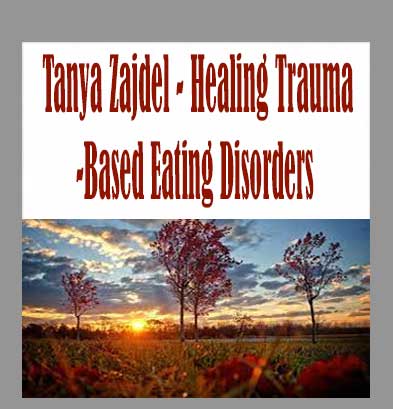Description
Tanya Zajdel – Healing Trauma-Based Eating Disorders download , Tanya Zajdel – Healing Trauma-Based Eating Disorders review , Tanya Zajdel – Healing Trauma-Based Eating Disorders free
Tanya Zajdel – Healing Trauma-Based Eating Disorders
Heal a dysregulated relationship with food after trauma.
Join this online Healing Trauma-Based Eating Disorders with expert-guided, 10-minute therapeutic exercises to harness deep inner healing by:
- Releasing old thought patterns about our body and nourishment
- Reclaiming inner safety for the trauma-affected nervous system
- Rebalancing the gut microbiome to reduce depressive symptoms
- Rewire self-talk to enhance body-positive thoughts and behaviors
- Reconnect with curiosity, playfulness, and creativity to stop food rumination
- Nurturing self-trust and compassion through therapeutic movement and somatics
If we’ve been affected by trauma, then we may experience cravings for unhealthy foods (Kuijer, 2012).
“Food isn’t just good for nourishment; it turns out that it can also help the body and the mind heal after trauma” – Dr. Gia Marson
Traditional forms of therapy – such as talk therapy – tend to overlook treating trauma at the gut-brain axis level.
Over the last decade, research has provided strong quantitative evidence for the relationship between trauma exposure and dysregulated eating (Breland et al., 2017).
Trauma can put the gut-brain axis into a hypermetabolic state, leading us to consume more food than we normally would.
This occurs because of our physiological responses to distress, which can manifest in symptoms such as an increased heart rate and heightened blood pressure (Kuijer, 2012).
When our energy levels are being drained faster than normal, we can end up craving foods that are calorie-dense rather than nutrient-dense (Kuijer, 2012).
These types of foods are often high in sugar, fat, and salt and can lead to an increase in our cortisol levels.
Cortisol is our main stress hormone, and heightened levels can affect our well-being and immunity (Kuijer, 2012).
In turn, trauma and distress can also have an impact on our eating patterns.
According to Dr. Gia Marson, it is common to experience:
- Eating without a routine
- Feeling a loss of control around food
- Restricting and strictly controlling eating
- Consuming foods high in fat, sugar, and salt
- Experiencing feelings of shame around food
- Binge eating
The gut and brain share a strong connection. A disruption at either end of the gut-brain axis impacts the other, meaning that emotional distress affects our eating, and our eating affects our emotional distress.
Thankfully, there are ways to harness the healing power of nutrition to help empower our recovery, not hamper it.
Research suggests that improving our emotional regulation is key to regulating our eating (Breland et al., 2017).
Techniques that can enhance emotional stability include breathwork, mindfulness, grounding practices, and somatic meditation (Bedworth, 2022; Douglass, 2009; Raypole, 2020; Savidaki et al., 2020; Oliver, 2015).
This Healing Trauma-Based Eating Disorders program incorporates these somatic techniques along with many others, as well as six expert-led theory modules, offering theoretical insight into understanding dysregulated eating behaviors and ways to heal these patterns.
We hope that by the end of this program, therapists and their clients will have discovered practical, safe, and effective methods that they can implement on their journey toward healing.
Introducing Healing Trauma-Based Eating Disorders: Techniques To Restore Our Relationship With Food And The Body
Seven Expert-Guided Techniques:
Technique 1: Body Neutrality Scan
Find an alternative to body negativity by connecting with the functions of each part of your body through a neutral lens to build your way up to body-positive thoughts and behavior.
Technique 2: Self-Love Connection
Support yourself in connecting to your body neutrally and lovingly. This simple grounding exercise involves taking the time to gently wash and care for your hands as a way to connect to your body.
Technique 3: Recovery Zones
This exercise involves creating awareness and planning strategies for recovery through mindfulness recovery behaviors. We will acknowledge and categorize our positive and negative behaviors using different-colored paper.
Technique 4: Acting Out Action Plan
Prepare for ED emergencies by learning how to create your own plan by incorporating multiple strategies and therapeutic modalities into a single bullet journal.
Technique 5: Recovery Mantras
Use mindfulness and creative expression to enhance your recovery voice through tangible recovery reminders and affirmations. This exercise draws on playfulness and creativity to reduce the panic or stress surrounding eating recovery.
Technique 6: Gratitude Practice
Delve deeper into self-love and compassion through meditation, breathing, and mindfulness. After this calming technique, we will engage in a free-flow writing exercise to write a letter to your body.
Technique 7: Supportive Schedule
Promote holistic wellness of food, thoughts, feelings, and actions through a recovery schedule to mobilize all the techniques and exercises you have learned thus far.
+ 3 Bonus Practical Recovery Exercises
- Nervous System Regulation
- The Raisin Exercise
- Reconnecting With The Body
Six Expert-Led Theory Modules:
Module 1: Understanding Eating Disorders With Marlene Van Den Berg (30-min)
- What is an eating disorder?
- Understanding the different types of eating disorders
- Exploring the ways that eating disorders can present themselves in thoughts and behaviors
- Understanding the cause of eating disorders
Module 2: Exploring Practical Tools And Techniques for Eating Disorders With Marlene Van Den Berg (23-min)
- Tackling the stigma of eating disorders
- Exploring how clinicians can help clients rescript their narrative
- Understanding the roles of different practitioners in providing support
Module 3: The Characteristics Of Disordered Eating With Dana Harron (23-min)
- Discover the spectrum of disordered eating and frequent issues
- Being treated as an object and its effects on self and worldview
- The aetiology of disordered eating
- Understanding how disordered eating is maintained
Module 4: Trauma, Physiological Effects, And Helpful Resources With Dana Harron (31-min)
- The link between trauma and disordered eating
- Physiological, neurological, and hormonal impacts of disordered eating
- Discover helpful resources for recovery
- Actionable techniques to help yourself or someone else
Module 5: Common Eating Disorders And The Challenges Of Recovery With Christopher Paul Szabo (44-min)
- Classification systems used when diagnosing an eating disorder
- Defining eating disorders
- The physical consequences of dysregulated eating
- The aetiology of eating disorders
- Issues with dieting
- Therapeutic approaches when working with eating disorders
- Stages of recovery & challenges with recovery
Module 6: Approaches To Treating Eating Disorders Through Patience And Trust With Christopher Paul Szabo (31-min)
- Different ways to treat eating disorders
- Difficulties in treating eating disorders
- Treatment caveats
- Understandings of “normal” eating
- Tips for therapists and clients on recovering from dysregulated eating
Frequently Asked Questions:
- Innovative Business Model:
- Embrace the reality of a genuine business! Our approach involves forming a group buy, where we collectively share the costs among members. Using these funds, we purchase sought-after courses from sale pages and make them accessible to individuals facing financial constraints. Despite potential reservations from the authors, our customers appreciate the affordability and accessibility we provide.
- The Legal Landscape: Yes and No:
- The legality of our operations falls into a gray area. While we lack explicit approval from the course authors for resale, there’s a technicality at play. When procuring the course, the author didn’t specify any restrictions on resale. This legal nuance presents both an opportunity for us and a boon for those seeking budget-friendly access.
- Quality Assurance: Unveiling the Real Deal:
- Delving into the heart of the matter – quality. Acquiring the course directly from the sale page ensures that all documents and materials are identical to those obtained through conventional means. However, our differentiator lies in going beyond personal study; we take an extra step by reselling. It’s important to note that we are not the official course providers, meaning certain premium services aren’t included in our package:
- No coaching calls or scheduled sessions with the author.
- No access to the author’s private Facebook group or web portal.
- No entry to the author’s exclusive membership forum.
- No direct email support from the author or their team.
We operate independently, aiming to bridge the affordability gap without the additional services offered by official course channels. Your understanding of our unique approach is greatly appreciated.
- Delving into the heart of the matter – quality. Acquiring the course directly from the sale page ensures that all documents and materials are identical to those obtained through conventional means. However, our differentiator lies in going beyond personal study; we take an extra step by reselling. It’s important to note that we are not the official course providers, meaning certain premium services aren’t included in our package:
Refund is acceptable:
- Firstly, item is not as explained
- Secondly, Item do not work the way it should.
- Thirdly, and most importantly, support extension can not be used.
Thank you for choosing us! We’re so happy that you feel comfortable enough with us to forward your business here.
- Innovative Business Model:








Reviews
There are no reviews yet.